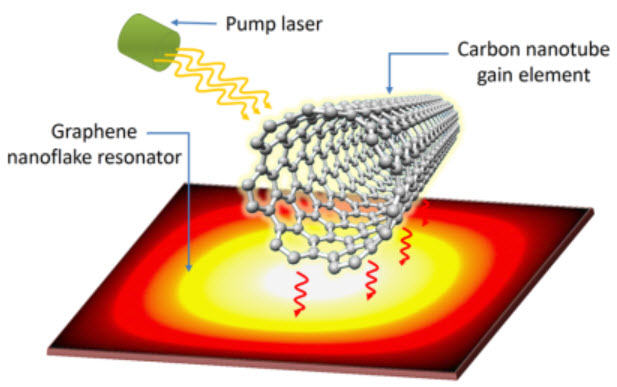Future smart phones could be printed on your clothes
April 30, 2014

Schematic of a proposed spaser comprising an optically pumped carbon nanotube located above a square graphene nanoflake resonator and generating surface plasmons (wavy lines) (credit: Monash University)
Monash University Department of Electrical and Computer Systems Engineering (ECSE) engineers have modeled the world’s first “spaser” (surface plasmon amplification by stimulated emission of radiation) to be made completely out of carbon.
Spasers are analogous to lasers, but generate surface plasmons (coherent electron oscillations) instead of photons.
PhD student and lead researcher Chanaka Rupasinghe said the modeled spaser design using carbon would offer many advantages. “Other spasers designed to date are made of gold or silver nanoparticles and semiconductor quantum dots, while our device would be comprised of a graphene resonator and a carbon nanotube gain element,” he said.
These materials are more than 100 times stronger than steel, can conduct heat and electricity much better than copper, and can withstand high temperatures, he noted.
Nanoelectronics printed on clothing
“Because of their outstanding mechanical, electrical and optical properties, graphene and carbon nanotubes can be used in applications where you need strong, lightweight, conducting, and thermally stable materials, and have been tested as nanoscale antennas, electric conductors, and waveguides,” Rupasinghe said.
His team’s research showed for the first time that graphene and carbon nanotubes can interact and transfer energy to each other through light. These optical interactions are very fast and energy-efficient, so they are suitable for electronic applications.
“Because of these properties, there is the possibility that in the future an extremely thin mobile phone could be printed on clothing,” he said. “Spaser-based devices could be used as an alternative to transistor-based devices such as microprocessors, memory, and displays to overcome current limitations in miniaturization and bandwidth.”
However, Rupasinghe noted in an email interview with KurzweilAI, companies have not yet started replacing electronic circuits with plasmonic circuits in large scale. “Furthermore, large-scale commercial production of graphene and carbon nanotubes is still under research. It will take at least a decade for carbon spasers to be available in commercial devices because replacing electronics with plasmonics is a technological revolution.”
Cancer therapy
“A spaser can generate high-intensity electric fields concentrated in a nanoscale space,” Rupasinghe said. “These fields are much stronger than those generated by using a laser for illuminating metal nanoparticles for applications such as cancer therapy.
“Scientists have already found ways to guide nanoparticles close to cancer cells. So we can move graphene and carbon nanotubes following those techniques, but use the highly concentrated fields generated through the spasing phenomena to destroy individual cancer cells without harming the healthy cells in the body.
“Other spasers designed to date are made of gold or silver nanoparticles and semiconductor quantum dots, while our device is comprised of a graphene resonator and a carbon nanotube gain element, making it completely carbon. This structure is robust, flexible, and capable of operating at high temperatures, and is friendly to the environment and the human body. ”
The research was described in a paper published in ACS Nano.
Abstract of ACS Nano paper
Spaser is a nanoscale source of surface plasmons comprising a plasmonic resonator and gain medium to replenish energy losses. Here we propose a carbon-based spaser design in which a graphene nanoflake (GNF) resonator is coupled to a carbon nanotube (CNT) gain element. We theoretically demonstrate that the optically excited CNT can nonradiatively transfer its energy to the localized plasmon modes of the GNF because of the near-field interaction between the modes and the CNT excitons. By calculating the localized fields of the plasmon modes and the matrix elements of the plasmon–exciton interaction, we find the optimal geometric and material parameters of the spaser that yield the highest plasmon generation rate. The results obtained may prove useful in designing robust and ultracompact coherent sources of surface plasmons for plasmonic nanocircuits.
